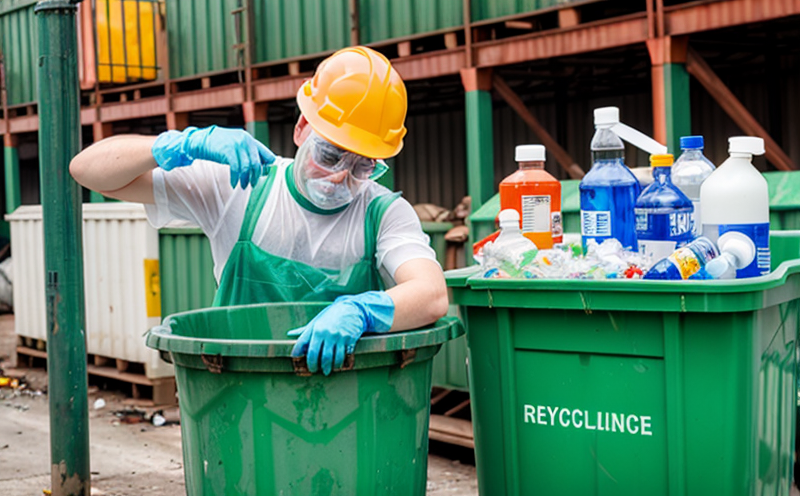ISO 6341 Acute Toxicity Testing of Waste Samples
The ISO 6341 standard is a cornerstone in environmental and chemical testing, providing methodologies to assess the acute toxicity levels of waste samples. This service plays a critical role in ensuring compliance with regulatory requirements for waste management and recycling processes.
Acute toxicity testing is essential for identifying hazardous materials that can pose immediate threats to human health, aquatic life, and ecosystems when released into the environment. Waste samples are often complex mixtures containing various compounds, some of which may be toxic at even low concentrations. This service helps in characterizing these potential hazards by simulating real-world scenarios where waste might come into contact with water or air.
The testing process involves exposing a standardized test organism to the waste sample under controlled conditions for a defined period. The organisms used are typically fish, daphnids (water fleas), or algae, depending on the toxicity endpoint being evaluated. The response of these organisms is then measured over time, providing data on the lethal concentration that affects 50% (LC50) or other relevant endpoints.
Compliance with ISO 6341 is crucial for industries handling hazardous waste, recycling facilities, and environmental protection organizations. It ensures that waste materials are managed responsibly, minimizing risks to public health and the environment. By accurately assessing toxicity levels, this service supports informed decision-making in regulatory compliance, risk assessment, and process optimization.
The testing protocol outlined in ISO 6341 is robust yet flexible, allowing for adjustments based on specific sample characteristics and regulatory requirements. This adaptability ensures that the test results are relevant to real-world scenarios, making the data generated highly valuable for decision-makers across various sectors.
Real-world applications of this service include:
- Evaluating waste streams from manufacturing processes
- Assessing recycling outputs before commercial release
- Determining compliance with local and international regulations
- Supporting R&D efforts in developing safer materials and processes
The accuracy of ISO 6341 testing is paramount, as even small differences in toxicity levels can have significant environmental impacts. Our laboratory adheres to stringent quality control measures, ensuring that all tests are conducted under the highest standards.
Scope and Methodology
| Test Parameter | Description | Method Used |
|---|---|---|
| Toxicity Endpoint | Lethal Concentration that affects 50% (LC50) of test organisms | ISO 6341-2: Acute Toxicity Testing Protocol |
| Test Organisms | Fish, Daphnids, or Algae depending on the endpoint being evaluated | Standardized Laboratory Conditions |
| Environmental Variables | Temperature, pH, and Salinity are controlled to mimic real-world conditions | Real-time Monitoring |
| Data Analysis | Statistical evaluation of survival rates and growth parameters | Compliance with ISO 6341-3: Data Interpretation Guidelines |
The scope of the testing includes a comprehensive examination of waste samples to determine their acute toxicity. This involves several key steps:
- Sample Preparation: Waste materials are carefully prepared according to ISO 6341 guidelines to ensure consistent and accurate results.
- Test Setup: The prepared samples are introduced into the test organisms' environment under controlled conditions, following strict protocol.
- Data Collection: Continuous monitoring of organism behavior is conducted over a defined period.
- Data Analysis: Statistical analysis of the collected data determines the toxicity level of the waste sample.
The results provide valuable insights into the potential risks associated with waste materials, aiding in informed decision-making for regulatory compliance and process optimization.
Quality and Reliability Assurance
At our laboratory, we are committed to delivering high-quality, reliable test results. Our ISO 6341 acute toxicity testing service is supported by a robust quality management system that ensures every aspect of the process adheres to international standards.
We employ highly trained and certified personnel who follow strict protocols throughout each stage of the testing process. Regular training sessions keep our team updated on the latest methodologies and best practices, ensuring consistency in results.
Our state-of-the-art facilities are equipped with advanced instrumentation that allows for precise measurement and monitoring of environmental variables during the test. This precision is crucial for obtaining accurate and reproducible results.
We also maintain strict quality control measures throughout the testing process, including regular calibration of instruments and validation of reagents. These measures ensure that our results are reliable and can be trusted by regulatory bodies and industry stakeholders.
In addition to internal controls, we participate in proficiency testing programs to further validate our capabilities. Our consistent performance in these programs demonstrates our commitment to excellence in quality assurance.
Competitive Advantage and Market Impact
- Compliance Leadership: Stay ahead of regulatory changes with up-to-date test methodologies.
- Market Differentiation: Gain a competitive edge by providing reliable, compliant data that reassures clients and stakeholders.
- Customer Satisfaction: Deliver accurate and timely results, supporting informed decision-making for waste management strategies.
- Innovation Support: Assist in R&D projects by identifying potential hazards early in the development process.
- Regulatory Assurance: Ensure compliance with international standards and local regulations, reducing the risk of non-compliance penalties.
- Sustainability Focus: Contribute to sustainable waste management practices by providing insights into safer alternatives.
By leveraging our expertise in ISO 6341 acute toxicity testing, we help clients navigate complex regulatory landscapes and make informed decisions that align with sustainability goals. Our service is a critical tool for ensuring the safe handling of hazardous waste, supporting both compliance and innovation within the industry.





